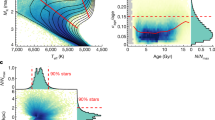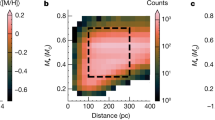Abstract
SIGNIFICANT progress has been made in recent years in the imaging of star-forming regions and in the theoretical modelling of the process of star formation1, but the physical process that determines the mass spectrum of stars remains unclear. Here we propose a model in which the protostar phase ends when the protostar embedded in a condensing core of molecular gas interacts with another protostar or star, and is ejected from its core. Such interactions must be important if stars preferentially form in dense but ultimately unbound protoclusters. In a simple model in which protostars accrete at a constant rate, the final distribution of stellar masses asymptotically approaches a simple universal distribution which is very similar to the observed mass function of stars. The general form of the mass function in this model is determined by a competition between accretion and collision rates, which provides a qualitative explanation for the differences in star formation in different environments (such as the galactic disk, globular clusters and the galactic halo).
This is a preview of subscription content, access via your institution
Access options
Subscribe to this journal
Receive 51 print issues and online access
$199.00 per year
only $3.90 per issue
Buy this article
- Purchase on Springer Link
- Instant access to full article PDF
Prices may be subject to local taxes which are calculated during checkout
Similar content being viewed by others
References
Shu, F. H., Adams, F. C. & Lizano, S. A. Rev. Astr. Astrophys. 25, 23–81 (1987).
Bertout, C. A. Rev. Astr. Astrophys. 27, 351–395 (1989).
Stahler, S. Astrophys. J. 332, 804–825 (1988).
Cayrel, R. in Physical Processes in Fragmentation and Star Formation (eds Capuzzo-Dolcetta, R., Chiosi, C. & Di Fazio, A.) 343–355 (Kluwer, Dordrecht, 1990).
Silk, J. & Takahashi, T. Astrophys. J. 229, 242–256 (1979).
Smith, G. H. Astrophys. J. 293, 251–257 (1985).
Herbig, G. H. & Terndrup, D. M. Astrophys. J. 307, 609–618 (1986).
Strom, K. M., Margulis, M. & Strom, S. E. Astrophys. J. 346, L33–L35 (1989).
Lada, E. A., DePoy, D. L., Evans, N. J. II & Gatley, I. Astrophys. J. 371, 171–182 (1991).
Myers, P. C. in The Formation and Evolution of Star Clusters (ed. Janes, K.) 73–77 (Astr. Soc. Pacific, San Francisco, 1991).
Pringle, J. E. Mon. Not. R. astr. Soc. 239, 361–370 (1989).
Solomon, P. M., Rivolo, A., Barrett, J. & Yahil, A. Astrophys. J. 319, 730–741 (1987).
Fuller, G. A. & Myers, P. C. Astrophys. J. 384, 523–527 (1992).
McKee, C. F. Astrophys. J. 345, 782–901 (1989).
Larson, R. B. Mon. Not. R. astr. Soc. 145, 271–295 (1969).
Shu, F. H. Astrophys. J. 214, 488–497 (1977).
Salpeter, E. E. Astrophys. J. 121, 161–167 (1955).
Scalo, J. M. Fund. Cosmic Phys. 11, 1–278 (1986).
Murray, S. D. & Lin, D. N. C. Astrophys. J. 339, 933–942 (1990).
Kraft, R. P. A. Rev. Astr. Astrophys. 17, 309–343 (1979).
Nomoto, K. in The Crab Nebula and Related Supernova Remnants (eds Kafatos, M. C. & Henry, R. B. C.) 97–113 (Cambridge Univ. Press, 1985).
Genzel, R. in The Physics of Star Formation and Early Stellar Evolution (eds Lada, C. J. & Kylafis, N. D.) 155–219 (Kluwer, Dordrecht, 1991).
Bally, J. & Lada, E. in The Formation and Evolution of Star Clusters (ed. Janes, K.) 35–39 (Astr. Soc. Pacific, San Francisco, 1991).
Garmany, C. D. in The Formation and Evolution of Star Clusters (ed. Janes, K.) 23–34 (Astr. Soc. Pacific, San Francisco, 1991).
Clarke, C. J. & Pringle, J. E. Mon. Not. R. astr. Soc. 249, 588–595 (1991).
Author information
Authors and Affiliations
Rights and permissions
About this article
Cite this article
Podsiadlowski, P., Price, N. Star formation and the origin of stellar masses. Nature 359, 305–307 (1992). https://doi.org/10.1038/359305a0
Received:
Accepted:
Issue Date:
DOI: https://doi.org/10.1038/359305a0
Comments
By submitting a comment you agree to abide by our Terms and Community Guidelines. If you find something abusive or that does not comply with our terms or guidelines please flag it as inappropriate.



